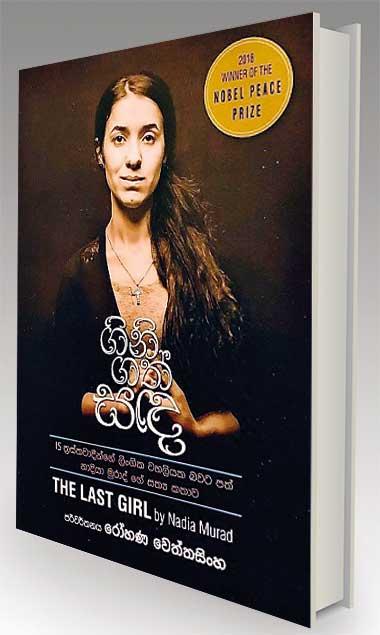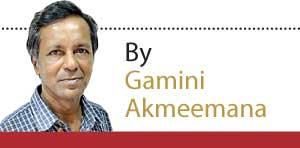17 Feb 2021 - {{hitsCtrl.values.hits}}
‘Last Girl: My Story of Captivity and My Fight Against the Islamic State’ by Nadia Murad (co-written with Jenna Krajeski) is no ordinary book. The story of a 21-year-old from Iraq’s Yezidi minority captured by Islamic State (ISIS) members in mid-2014, is the most harrowing biography I have ever read. This modern tale of horror, the repulsive result of religious extremism and depravity has now been translated into Sinhala by Rohana Wettasinghe as ‘Gini Gath Sanda.’
Jenna Krajeski) is no ordinary book. The story of a 21-year-old from Iraq’s Yezidi minority captured by Islamic State (ISIS) members in mid-2014, is the most harrowing biography I have ever read. This modern tale of horror, the repulsive result of religious extremism and depravity has now been translated into Sinhala by Rohana Wettasinghe as ‘Gini Gath Sanda.’
Nadia Murad, winner of the 2018 Nobel Peace Prize and the UN Goodwill Ambassador for the Dignity of Survivors of Human Trafficking, was barely 21 when her village in Iraq’s northern Sinjar region was captured by ISIS during its lightning advance which gave them control of 56,000 sq km of Iraqi territory containing 4.5 million people.
For sheer brutality towards captives, civilian or military, ISIS remains unsurpassed in modern history, rivalled only by the Nazis. But the Islamic State did one thing even the Nazis did not think of – they came with an official agenda of using women captives as sex slaves, to be sold and exchanged at will. While Lord Russell of Liverpool in his comprehensive study of Nazi war crimes, ‘The Scourge of the Swastika’ details individual cases of rape and abuse of women in the concentration camps and occupied territories of Eastern Europe (where the Jews and Slavic peoples were considered to be sub human, or untermenschen), the Nazis did not approve of sexual contact of the ‘master race’ with their supposed inferiors.
"Nadia Murad, winner of the 2018 Nobel Peace Prize and the UN Goodwill Ambassador for the Dignity of Survivors of Human Trafficking, was barely 21 when her village in Iraq’s northern Sinjar region was captured by ISIS"
 The ISIS had no such worries. As hated ‘heretics’, the Yezidi minority of northern Iraq had faced persecution from majority Muslim neighbours over the centuries. The Yezidi faith is a mixture of Islam, Judaism and pre-Islamic non-monotheistic faiths. But they managed to survive even under the brutal reign of Saddam Hussein (Nadia Murad mentions 73 attempts to destroy the Yezidis before the 2014 ISIS conquest). The Islamic State’s lightning advance took the Yezidis, a poor rural community, by surprise, and many of them naively thought they would be left alone while the newly arrived black clad warriors moved on to greater conquests elsewhere.
The ISIS had no such worries. As hated ‘heretics’, the Yezidi minority of northern Iraq had faced persecution from majority Muslim neighbours over the centuries. The Yezidi faith is a mixture of Islam, Judaism and pre-Islamic non-monotheistic faiths. But they managed to survive even under the brutal reign of Saddam Hussein (Nadia Murad mentions 73 attempts to destroy the Yezidis before the 2014 ISIS conquest). The Islamic State’s lightning advance took the Yezidis, a poor rural community, by surprise, and many of them naively thought they would be left alone while the newly arrived black clad warriors moved on to greater conquests elsewhere.
They were utterly wrong. Ethnic cleansing of the Yezidis and other minorities, including Assyrian Christians, Turkmen Shi’a, Shabak Shi’a, Kakai and Sabean Mandaeans began soon after August 2014. The Yezidis were abandoned by the Kurdish Peshmerga militia which had promised them protection. In a mass killing in the village of Kocho, Nadia’s mother and six brothers were killed by ISIS members along with almost all the males of Kocho.
All younger women including teenage girls were taken to cities such as Mosul, where they were forced to convert to Islam and then sold by auction to ISIS members. Realising that her new master was going to be a huge, brutish ISIS member called Salwan, she pleads with an aged cleric called Hajji Salman to take her instead.
"The Yezidis were abandoned by the Kurdish Peshmerga militia which had promised them protection. In a mass killing in the village of Kocho, Nadia’s mother and six brothers were killed by ISIS members along with almost all the males of Kocho"
He does, and the following chapters are hard to read. When she attempts escape, he whips her and lets his guards rape her. We now think of the grimmest chapters of history, such as the massacre of Armenians by Turkey after World War I and the Nazi atrocities, as past events which cannot happen again. But history repeats itself – as it did in Rwanda, Bosnia and most recently in Iraq under ISIS. This is the point that Nadia Murad makes again and again – that civilization is just a veneer.
Even without war, criminals and psychopaths all over the world commit unspeakable acts against the innocent. But the Islamic State introduced a new dimension to such aberrations. Sex slavery was an official agenda. According to their doctrine, heretics such as the Yezidis were less than human. To be acceptable, they had to convert to Islam, or die. But that wasn’t the end of the story. They remained slaves even after conversion, which gave them a ‘market value’ for sex slavery.
But this twisting of existing doctrines is common to extremists of all faiths, not just that of radical Islam. It’s just that the Islamic State had an unparalleled run in northern Iraq to put their twisted theories into practice for three long years. Let no one forget that genesis of ISIS can be traced back to the Soviet invasion of Afghanistan, followed by the nurturing of Islamic militancy as a weapon of cold war by the United States and its ally Pakistan. All these international power players and their dirty political games have a direct link with what happened to Nadia Murad and thousands of young women like her.
27 Nov 2024 13 minute ago
27 Nov 2024 23 minute ago
27 Nov 2024 27 minute ago
27 Nov 2024 45 minute ago
27 Nov 2024 2 hours ago